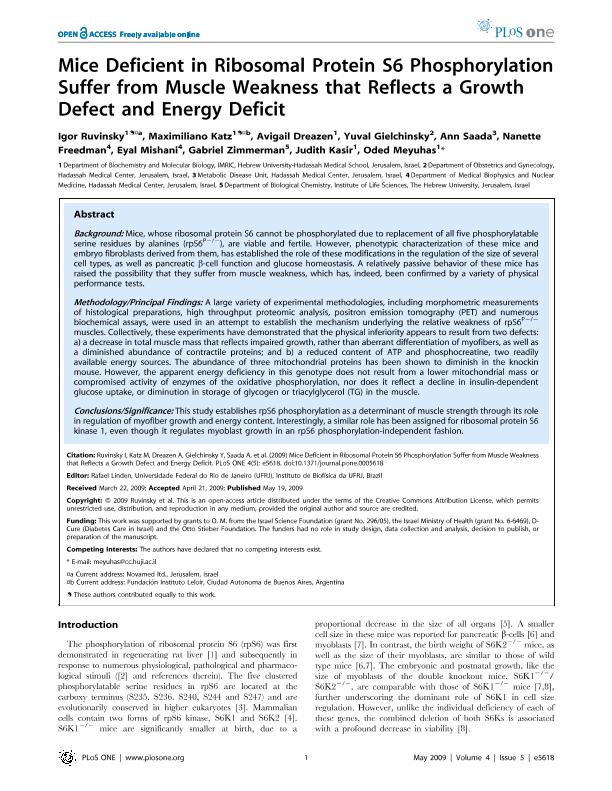Artículo
Mice deficient in ribosomal protein S6 phosphorylation suffer from muscle weakness that reflects a growth defect and energy deficit
Ruvinsky, Igor; Katz, Maximiliano Javier ; Dreazen, Avigail; Gielchinsky, Yuval; Saada, Ann; Freedman, Nanette; Mishani, Eyal; Zimmerman, Gabriel; Kasir, Judith; Meyuhas, Oded
; Dreazen, Avigail; Gielchinsky, Yuval; Saada, Ann; Freedman, Nanette; Mishani, Eyal; Zimmerman, Gabriel; Kasir, Judith; Meyuhas, Oded
 ; Dreazen, Avigail; Gielchinsky, Yuval; Saada, Ann; Freedman, Nanette; Mishani, Eyal; Zimmerman, Gabriel; Kasir, Judith; Meyuhas, Oded
; Dreazen, Avigail; Gielchinsky, Yuval; Saada, Ann; Freedman, Nanette; Mishani, Eyal; Zimmerman, Gabriel; Kasir, Judith; Meyuhas, Oded
Fecha de publicación:
05/2009
Editorial:
Public Library of Science
Revista:
Plos One
ISSN:
1932-6203
e-ISSN:
1932-6203
Idioma:
Inglés
Tipo de recurso:
Artículo publicado
Clasificación temática:
Resumen
BACKGROUND: Mice, whose ribosomal protein S6 cannot be phosphorylated due to replacement of all five phosphorylatable serine residues by alanines (rpS6(P-/-)), are viable and fertile. However, phenotypic characterization of these mice and embryo fibroblasts derived from them, has established the role of these modifications in the regulation of the size of several cell types, as well as pancreatic beta-cell function and glucose homeostasis. A relatively passive behavior of these mice has raised the possibility that they suffer from muscle weakness, which has, indeed, been confirmed by a variety of physical performance tests. METHODOLOGY/PRINCIPAL FINDINGS: A large variety of experimental methodologies, including morphometric measurements of histological preparations, high throughput proteomic analysis, positron emission tomography (PET) and numerous biochemical assays, were used in an attempt to establish the mechanism underlying the relative weakness of rpS6(P-/-) muscles. Collectively, these experiments have demonstrated that the physical inferiority appears to result from two defects: a) a decrease in total muscle mass that reflects impaired growth, rather than aberrant differentiation of myofibers, as well as a diminished abundance of contractile proteins; and b) a reduced content of ATP and phosphocreatine, two readily available energy sources. The abundance of three mitochondrial proteins has been shown to diminish in the knockin mouse. However, the apparent energy deficiency in this genotype does not result from a lower mitochondrial mass or compromised activity of enzymes of the oxidative phosphorylation, nor does it reflect a decline in insulin-dependent glucose uptake, or diminution in storage of glycogen or triacylglycerol (TG) in the muscle. CONCLUSIONS/SIGNIFICANCE: This study establishes rpS6 phosphorylation as a determinant of muscle strength through its role in regulation of myofiber growth and energy content. Interestingly, a similar role has been assigned for ribosomal protein S6 kinase 1, even though it regulates myoblast growth in an rpS6 phosphorylation-independent fashion.
Palabras clave:
Muscle Weakness
,
Glucose Homeostasis
,
Ribosomal Protein S6
,
Myoblast
Archivos asociados
Licencia
Identificadores
Colecciones
Articulos(IIBBA)
Articulos de INST.DE INVEST.BIOQUIMICAS DE BS.AS(I)
Articulos de INST.DE INVEST.BIOQUIMICAS DE BS.AS(I)
Citación
Ruvinsky, Igor; Katz, Maximiliano Javier; Dreazen, Avigail; Gielchinsky, Yuval; Saada, Ann; et al.; Mice deficient in ribosomal protein S6 phosphorylation suffer from muscle weakness that reflects a growth defect and energy deficit; Public Library of Science; Plos One; 4; 5; 5-2009; e5618
Compartir
Altmétricas



